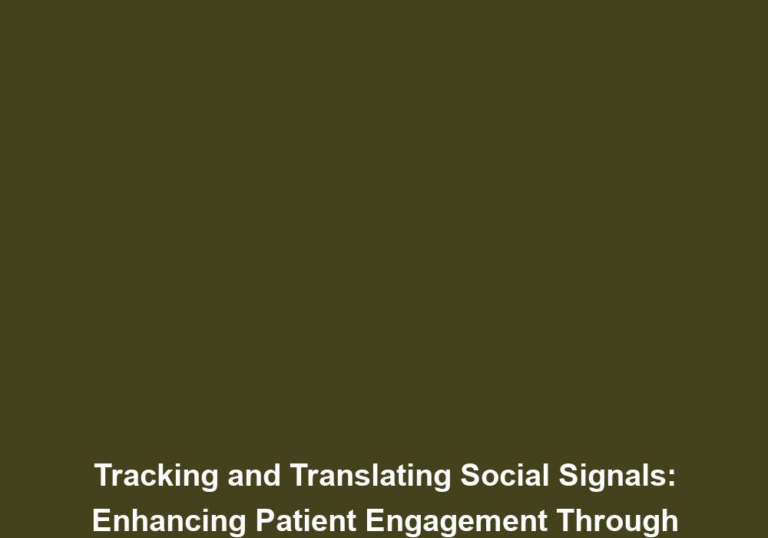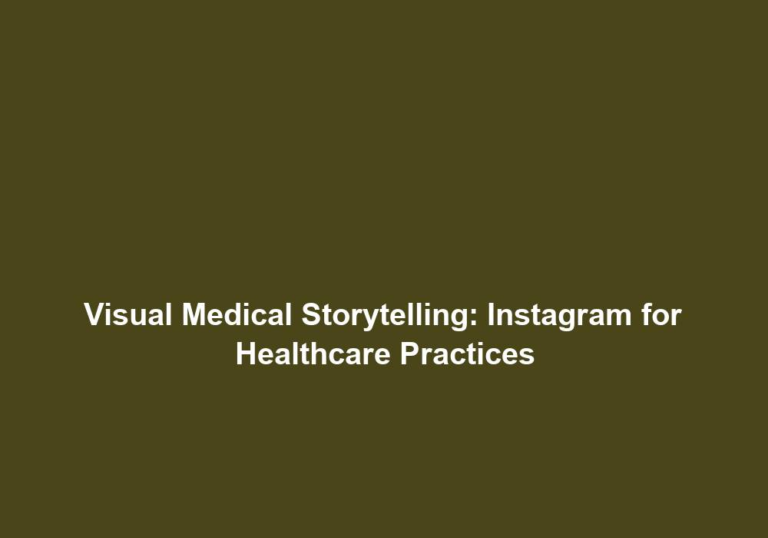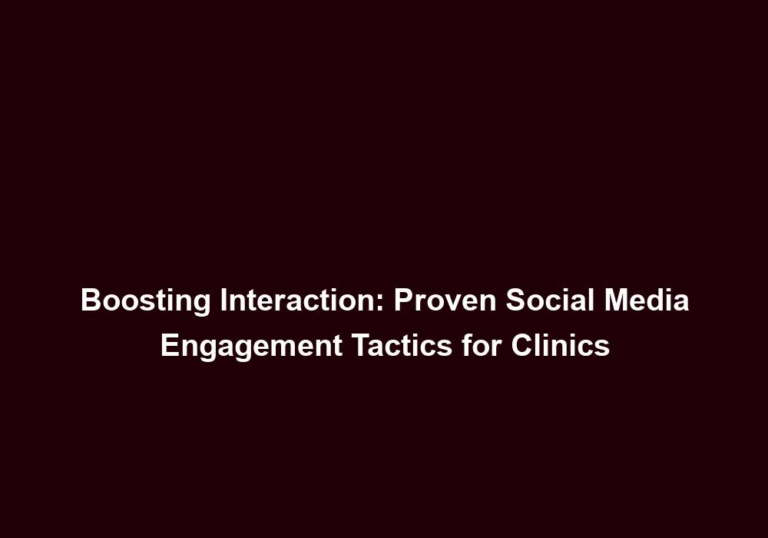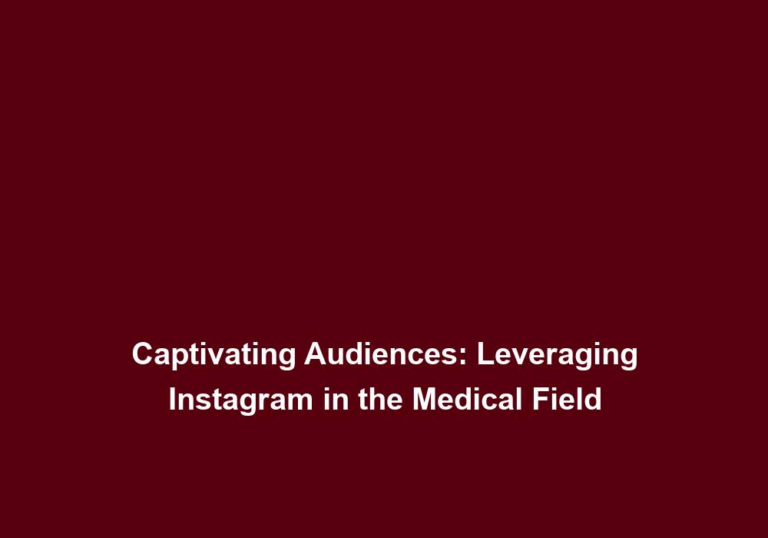Making Sense of Social Metrics: How Analytics Drive Better Patient Engagement
In today’s digital age, social media has become an influential platform for communication and information sharing. It has revolutionized the way we connect with others, including healthcare providers and patients. As a result, understanding and utilizing social metrics has become essential in enhancing patient engagement and improving the overall success of healthcare practices.
Importance of Social Metrics in Patient Engagement
Before delving into the details of social metrics and analytics, let’s first understand why they are crucial for patient engagement:
-
Measuring Reach and Impact: Social metrics provide valuable insights into the reach and impact of your healthcare practice’s social media presence. By tracking metrics such as followers, likes, comments, shares, and click-through rates, you can evaluate the effectiveness of your online content and identify areas for improvement. These metrics allow you to understand how many people are being exposed to your content and how they are interacting with it.
-
Identifying Patient Preferences: Social media platforms allow patients to engage with your practice, share their experiences, and express their preferences. By analyzing social metrics, you can gain a deeper understanding of patient preferences, concerns, and interests. This knowledge can guide your content creation and engagement strategies, leading to a more tailored and personalized patient experience. For example, by analyzing engagement metrics such as likes, comments, and shares, you can identify which types of content resonate the most with your audience and create more of that content.
-
Building Trust and Credibility: Social metrics act as indicators of your healthcare practice’s reputation and credibility. Positive engagement metrics, such as high levels of interaction and positive feedback, can enhance your practice’s online reputation and instill trust in potential patients. Conversely, negative metrics can highlight areas for improvement and prompt proactive measures to address patient concerns. By monitoring these metrics, you can identify any negative feedback or issues and take prompt action to address them, thereby building trust and credibility with your patients.
-
Tracking Patient Satisfaction: Social media platforms can serve as platforms for patients to voice their opinions, whether positive or negative. By monitoring social metrics, you can gauge patient satisfaction levels, identify potential issues, and respond promptly to address concerns, thereby improving patient experience and loyalty. For example, by analyzing sentiment analysis metrics, you can proactively address any negative feedback or issues, further enhancing patient engagement and satisfaction.
Understanding Social Metrics and Analytics
To make the most of social metrics, it is crucial to understand the different types of metrics and how they can be analyzed:
1. Audience Metrics
Audience metrics provide insights into your social media following, including the demographic profile, interests, and behavior of your audience. Key audience metrics to consider include:
- Follower Count: The number of individuals following your healthcare practice’s social media accounts. This metric gives you an idea of the size of your audience and the potential reach of your content.
- Demographics: Information about your followers’ age, gender, location, and other relevant characteristics. Understanding these demographics can help you tailor your content to better resonate with your target audience.
- Engagement Rate: The percentage of your followers who actively engage with your content through likes, comments, shares, etc. This metric indicates how well your content is connecting with your audience and can help you identify areas for improvement.
Analyzing audience metrics can help you tailor your content to better resonate with your target audience and attract new patients. For example, if you find that a majority of your followers are in a specific age group, you can create content that specifically caters to their interests and needs.
2. Engagement Metrics
Engagement metrics indicate how your audience interacts with your content. Examples of engagement metrics include:
- Likes: The number of likes received on your posts. This metric shows how well your content is received and how many people find it valuable or interesting.
- Comments: The number of comments left on your posts. This metric indicates the level of engagement and discussion sparked by your content.
- Shares: The number of times your content is shared by others. This metric shows how widely your content is being distributed and the level of interest it generates.
- Click-through Rate (CTR): The percentage of people who click on links within your social media posts. This metric measures the effectiveness of your call-to-action and the level of interest in the content you are promoting.
By analyzing engagement metrics, you can identify the type of content that generates the most interest and engagement. This knowledge enables you to create more effective content and drive increased patient engagement. For example, if you notice that videos receive more likes, comments, and shares compared to other types of content, you can focus on creating more video content to engage your audience.
3. Conversion Metrics
Conversion metrics measure the effectiveness of your social media efforts in driving patient actions, such as appointment bookings, newsletter sign-ups, or website visits. Key conversion metrics include:
- Clicks: The total number of clicks on your social media posts, links, or promotions. This metric indicates the level of interest in your content and the effectiveness of your call-to-action.
- Conversion Rate: The percentage of individuals who take the desired action after clicking on your social media content. This metric measures the success of your social media campaigns in driving patient actions.
Analyzing conversion metrics helps you understand the ROI of your social media campaigns and optimize your strategies to achieve better results. For example, if you find that a particular type of content consistently leads to a high conversion rate, you can focus on creating more of that content to drive patient actions.
Leveraging Social Metrics for Better Patient Engagement
Now that we understand the importance of social metrics and how to analyze them, let’s explore effective strategies for leveraging these insights to enhance patient engagement:
1. Content Strategy Optimization
Utilize social metrics to refine and optimize your content strategy. Analyze engagement metrics to identify which types of content resonate the most with your audience. Experiment with different formats, such as videos, infographics, or blog posts, and monitor metrics to determine the most effective content formats for driving patient engagement. By continuously analyzing engagement metrics, you can fine-tune your content strategy to meet the evolving needs and preferences of your audience.
2. Personalized Patient Communication
Leverage audience metrics to segment your social media followers and tailor your communication accordingly. By understanding your audience’s demographics and interests, you can deliver personalized content that addresses their specific needs and preferences. This approach fosters a sense of connection and increases the likelihood of meaningful patient engagement. For example, if you find that a significant portion of your audience consists of young parents, you can create content that provides helpful tips and advice for parenting.
3. Prompt and Proactive Engagement
Monitoring engagement metrics allows you to identify and respond promptly to patient comments, concerns, and inquiries. Prompt engagement demonstrates your practice’s commitment to patient satisfaction and fosters trust and loyalty. Additionally, analyzing sentiment analysis metrics can help you proactively address any negative feedback or issues, further enhancing patient engagement and satisfaction. For example, if you notice a negative comment about your practice on social media, responding promptly and addressing the concern publicly shows that you value patient feedback and are committed to resolving any issues.
4. Continuous Improvement
Regularly track and analyze social metrics to measure the effectiveness of your patient engagement strategies. Identify areas for improvement based on conversion metrics and adjust your approach accordingly. By continuously optimizing your social media efforts, you can drive better patient engagement and achieve long-term success. For example, if you find that a particular social media campaign is not yielding the desired conversion rate, you can analyze the campaign’s performance and make necessary adjustments to improve the results.
In conclusion, social metrics and analytics play a pivotal role in driving better patient engagement in the digital era. By understanding and utilizing these metrics effectively, healthcare practices can tailor their content, build trust, and foster meaningful connections with patients. Embracing social metrics as part of your patient engagement strategy will not only improve patient satisfaction but also contribute to the overall success and growth of your healthcare practice.







